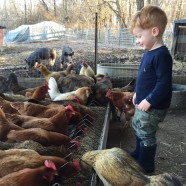Backyard Chickens for Eggs
A lot of folks have asked about backyard chickens recently. There are a few projects that you can start today that will yield food and satisfaction for years to come. If this is something you are going to do, order your birds now, then you’ll have about 4-6 weeks to build your coop. The first question to answer is what and where to get chicks or more mature birds. We have always purchased our birds through the mail. You read that right: we have had up to 180 birds shipped to our post office! You will likely need a smaller quantity, so your order will be no sweat for the hatchery and the US Postal Service. There are several hatcheries you can choose from, but we have found Murray McMurray hatchery to be reliable. You can order chicks (about $3-$4 each) or more mature pullets ($25 each). While chicks are less expensive, they are very fragile and can die very easily in cold weather, even with heat lamps. More mature birds will cost you more upfront, but have a lower mortality rate as the temperatures fluctuate this time of year. Pullets also have a head start over chicks, and will begin producing eggs sooner. If you are willing to wait and have a space to keep them warm, chicks are the most economical option. The next step is selecting your birds, mainly deciding on white, brown and or easter egg layers. Breed determines what color eggs your hens will lay. Our favorite birds are New Hampshire Reds, hearty brown egg layers who will lay, on average, an egg a day. Most hens will lay as often as every 26 hours; it’s part of their lady process and they do not require a rooster. Unless you (and your neighbors) want a solar powered alarm clock that is often known for a foul (no pun intended) attitude, you can get by with females only. How many!? One egg every 26 hours, means about 4-5 eggs a day from 6 birds – every. single. day. (Your girls will start reliably laying at around 22-26 weeks old). Get a few extra in case they don’t make it all the way to maturity. If you have 12 birds you can make gifts of your eggs or sell them to help buy feed. Kentucky’s laws make it pretty easy to sell your backyard eggs, so long as you keep it to less than 720 eggs a week. The post office will call you on the day your chicks arrive. Here, they call at about 5:55am and ask (please hurry) when we’re planning on retrieving our box of constantly peeping chicks from their offices (usually you can hear them in the background). When you receive that box you are officially in the chicken farming business! What you’ll need for the first few weeks: A baby pool or other type of high sided enclosure, and make sure it is plastic and easily cleaned. Speaking of cleaning, you’ll need some shavings to help absorb the waste. Get a waterer and a feeder. Often times you will find a miniature versions of these for chicks, we have not found them to be necessary. We will typically feed chicks out of the base tray of a large feeder (google hanging feeder). We finally got tired of spilling water and bought plasson bell broiler drinkers – they make life a breeze to refill using gravity and a 5 gallon bucket. Chick starter feed. We buy Brumley Non-GMO crumbles from Bagdad Roller Mills in Bagdad, Kentucky....
Read MoreMeal planning with a Whole Chicken
We sell whole, processed chickens, packaged similarly to whole chickens found in the traditional grocery store. Many people are used to buying chicken pieces, like breasts, thighs, and wings, so it may be unfamiliar to purchase and prepare a whole chicken. We’re here to help with recipes and meal planning ideas.
Read MoreHall’s Hill Rice
We love to use as much of our pork and chicken as possible. After all, we have labored and prayed over our meat for months before it reaches the table! So we respect the animals and the effort by wasting very little. Making chicken broth is just one way we use the bones and scraps that would otherwise be trash. With the broth, we make a variety of meals, including rice.
Read More2016 Begins on the Farm
Things are picking up on the farm… So far we have two hogs, 30+/- layers, and a few eager helpers – we are excited for all the Lord has in store for HHF in 2016! We are planning to sell whole and half hogs again this year, as well as chickens. Let us know if you’re interested in either – last year the hogs were claimed quickly! We will be accepting initial deposits soon, so keep up with us on Facebook and here on the blog for the latest info. We look forward to supplying your family with pasture-raised pork and poultry this...
Read MoreBuilding a Chicken Tractor, Step by Step
This coop is an adaption of Joel Salatin’s chicken tractors. I have seen his tractors but have never found a design online and finally just had to guess a bit and build one. I built a coop a few years ago which turned out to be too heavy to move efficiently. I literally went to the drawing board last year and came out with a Salatin-esque tractor.
Read MoreOur first year with Aunty Barbara, our Livestock Guard Dog
Before Barb, it was open season on chickens and any stored feed. We effectively had a neon sign above the barn flashing “Open Late!” Attracted were all types of predators common to Kentucky: possum, raccoons, and foxes. (We never encountered coyotes, probably given the proximity of house to barn). Despite the lack of coyote sightings, there were hoards of others. Fox were the main problem with the chickens. Rumors have gone around that a neighbor has supported the breeding and release of fox in the area to promote fox hunting. With or without a breeding neighbor, our chickens were attacked mercilessly by foxes. Foxes kill for sport (as many as possible) then make off with one or two. The sight of a dozen chickens in various states of dismemberment is one of the most demoralizing things we have encountered on farm. But it was becoming frequent, and coupled with raccoons gorging themselves on feed, we finally quit chickens altogether.
Read More


